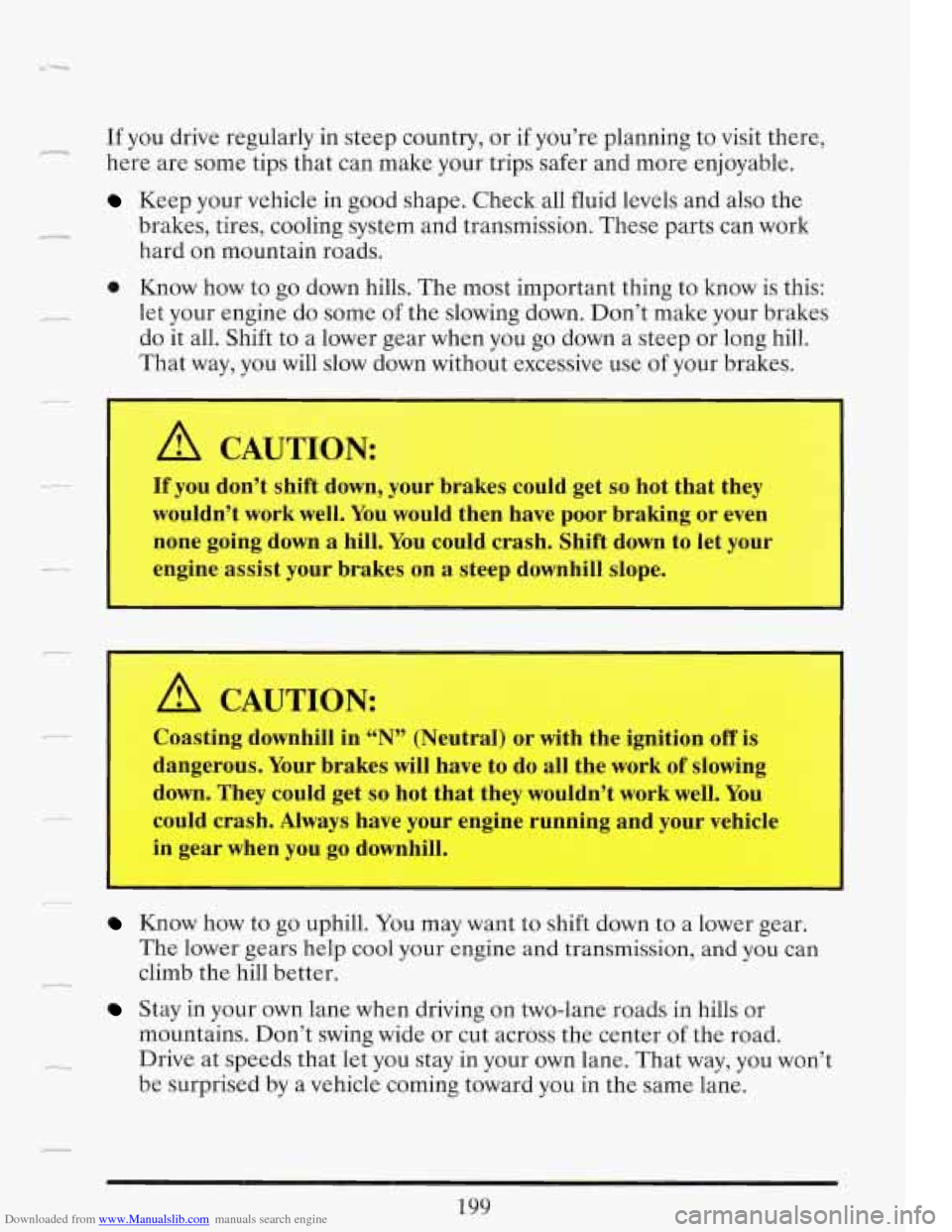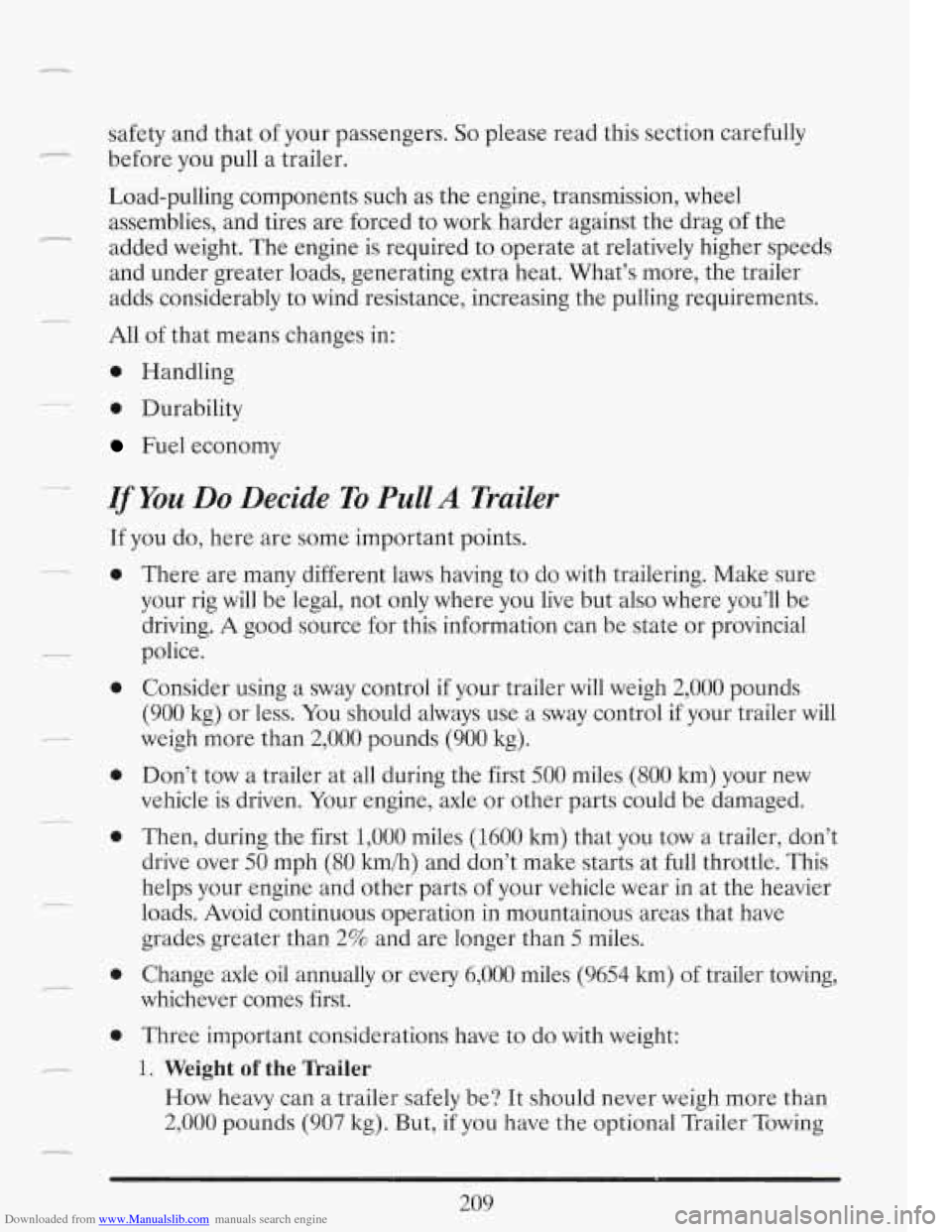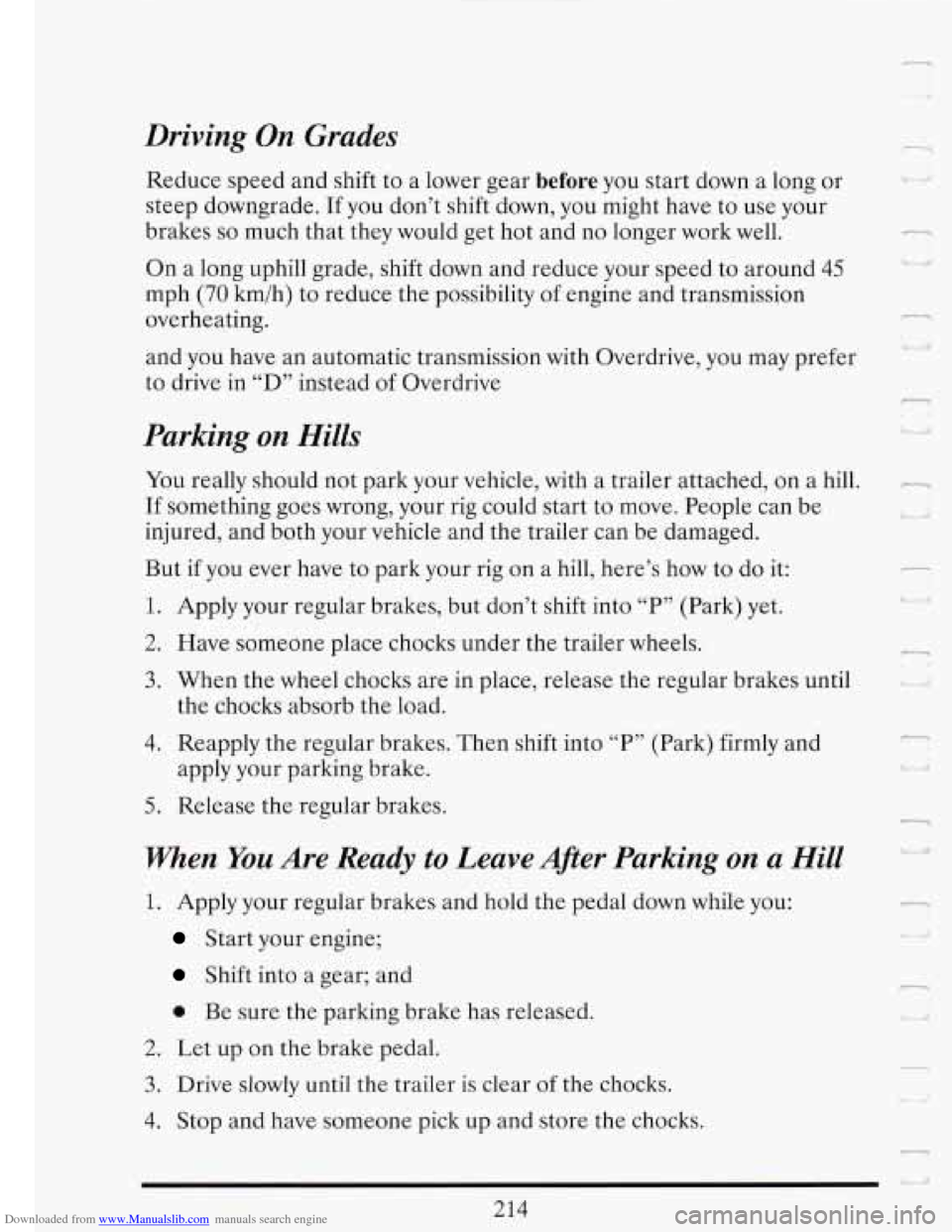Page 126 of 386
Downloaded from www.Manualslib.com manuals search engine The high beam headlights will come on at reduced brightness in daylight
when:
The ignition is on
The headlight switch is off, and
The transmission is not in “P” (Park).
At dusk, the DRL will switch off and the exterior lights
will come on
automatically. At dawn, the exterior lights will go out and the high beams
will change to the reduced brightness
of DRL (if the headlight switch is -
off).
Of course, you may still turn on the headlights any time you need to. W
To idle your vehicle with the DRL off, shift the transmission into “P”
(Park), turn the ignition
OFF, and then restart your engine. The DRL will -.
stay off until you shift out of “P” (Park). cd. 1
Reading Lights
Here’s where you turn them on:
n
c1 ’!
112
Page 132 of 386
Downloaded from www.Manualslib.com manuals search engine ASTROROOF
If you have this option, the switch is here:
_.
If you have this option, you have a safety glass panel and a sunshade.
With the handle, you can slide your sunshade open or closed. When your
ignition is
in Run, move the switch toward the rear of the car to open the
roof.
To close it, move the switch toward the front of your car. Once the
roof is closed, you can let
go of the switch and then push the front of it
again. This opens the roof at the rear to a vent position.
TWLER TOWING PACKAGE (OPTION)
If your Fleetwood is equipped with this package, you can increase your 7
vehicle's trailer towing capability to 7,000 pounds (3175 kg). This package '
includes a trailering harness, heavy-duty engine and transmission cooling,
and heavy-duty radiator.
Also included are heavy-duty front and rear
springs, 3.73:l rear axle ratio and P235/70R15
ALZ whitewall tires.
7
n
Page 142 of 386
Downloaded from www.Manualslib.com manuals search engine A CAUTION:
If you let your tires spin at high speed when the “Ikaction
Disabled” light comes on, your tires can explode and you or
others could be injured. And, spinning your tires with this light
on can cause the automatic transmission to overheat or can
cause other problems that could cause an engine fire or other
damage. When you’re stuck, spin the wheels as little as possible.
If your vehicle is stuck, don’t spin the wheels above 35 mph (55
h/h) a 1 on the speedometer.
Engine Coolant Temperature Warning Light
h
T
This light tells you that
your engine coolant has
overheated.
If you have
been operating your
vehicle under normal
driving conditions,
you
should pull off the
road, stop your vehicle
and turn the engine
off
as soon as possible.
P
L 4.
-
u c
128
Page 213 of 386

Downloaded from www.Manualslib.com manuals search engine c If you drive regularly in steep country, or if you’re planning to visit there,
here are some tips that can make your trips safer and more enjoyable.
Keep your vehicle in good shape. Check all fluid levels and also the
brakes, tires, cooling system and transmission. These parts can work
hard on mountain roads.
0 Know how to go down hills. The most important thing to know is this:
let your engine do some
of the slowing down. Don’t make your brakes
do it all. Shift to a lower gear when you go down a steep or long hill.
That way, you will slow down without excessive use
of your brakes.
I_ I
I
I A CAUTION:
If you don’t shift down, your brakes could get so hot that they
wouldn’t work well. You would then have poor braking or even
none going down a hill. You could crash. Shift down to let your
engine assist your brakes on
a steep downhill slope.
I
A CAUTION:
- I Coasting downhill in “N” (Neutral) or with the ignition off is
dangerous. Your brakes
will have to do all the work of slowing
down. They could get
so hot that they wouldn’t work well. You
could crash. Always have your engine running and your vehicle
in gear when you go downhill.
I
Know how to go uphill. You may want to shift down to a lower gear.
The lower gears help cool your engine and transmission, and you can
e.-- climb the hill better.
,-
Stay in your own lane when driving on two-lane roads in hills or
mountains. Don’t swing wide or cut across the center of the road.
Drive at speeds that let you stay in your own lane. That way, you won’t
be surprised by a vehicle coming toward you in the same lane.
Page 216 of 386
Downloaded from www.Manualslib.com manuals search engine I
I
If you’re going uphill
on a one-way street
and you’re parking on
the left side, your
wheels should point to
the right.
If there is no curb
when you’re parking
uphill, turn the wheels
to the right.
Q
Q
If there is no curb when you’re parking uphill on the left side of a
one-way street, your wheels should be turned to the left.
Torque Lock (Automatic Transmission)
If you are parking on a hill and you don’t shift your transmission into “P”
(Park) properly, the weight of the vehicle may put too much force on the
parking pawl in the transmission. You may find it difficult to pull the shift
lever out of “P” (Park). This is called “torque lock.”
To prevent torque
lock, always be sure to shift into “P’, (Park) properly before you leave the
driver’s seat. To find out how, see “Shifting Into ‘P’ (Park)” in the Index.
202
Page 217 of 386
Downloaded from www.Manualslib.com manuals search engine r
If “torque lock” does occur, you may need to have another vehicle push
yours a little uphill to take some
of the pressure from the transmission, so
you can pull the shift lever out of “P” (Park).
WINTER DRWTNG
Here are some tips for winter driving:
Have your Cadillac in good shape for winter. Be sure your engine
Snow tires can help in loose snow, but they may give you less traction
on ice than regular tires. If you do not expect to be driving in deep
snow, but may have to travel over ice, you may not want to switch to
snow tires at all.
coolant
mix is correct.
You may want to put winter emergency supplies in your trunk.
203
Page 223 of 386

Downloaded from www.Manualslib.com manuals search engine *_
safety and that of your passengers. So please read this section carefully
before you pull a trailer.
Load-pulling components such as the engine, transmission, wheel
assemblies, and tires are forced to work harder against the drag
of the
added weight. The engine is required to operate at relatively higher speeds
and under greater loads, generating extra heat. What’s more, the trailer
adds considerably to wind resistance, increasing the pulling requirements.
All of that means changes in:
0 Handling
0 Durability
Fuel economy
If You Do Decide To Pull A Trailer
If you do, here are some important points.
0
0
0
0
0
0
There are many different laws having to do with trailering. Make sure
your rig will be legal, not only where you live but also where you’ll be
driving.
A good source for this information can be state or provincial
police.
Consider using a sway control if your trailer will weigh
2,000 pounds
(900 kg) or less. You should always use a sway control if your trailer
will
weigh more than 2,000 pounds (900 kg).
Don’t tow a trailer at all during the first 500 miles
(800 km) your new
vehicle is driven. Your engine, axle or other parts could be damaged.
Then, during the first
1,000 miles (1600 km) that you tow a trailer, don’t
drive over
50 mph (80 km/h) and don’t make starts at full throttle. This
helps your engine and other parts of your vehicle wear in at the heavier
loads. Avoid continuous operation
in mountainous areas that have
grades greater than
2% and are longer than 5 miles.
Change axle
oil annually or every 6,000 miles (9654 km) of trailer towing,
whichever comes first.
Three important considerations have to do with weight:
1. Weight of the nailer
How heavy can a trailer safely be? It should never weigh more than
2,000 pounds (907 kg). But, if you have the optional Trailer Towing
Page 228 of 386

Downloaded from www.Manualslib.com manuals search engine Driving On Grades
Reduce speed and shift to a lower gear before you start down a long or
steep downgrade. If you don’t shift down, you might have to use your
brakes
so much that they would get hot and no longer work well.
On a long uphill grade, shift down and reduce your speed to around 45
mph (70 kmih) to reduce the possibility of engine and transmission
overheating.
19 1
d l
n 1, ia
and you have an automatic transmission with Overdrive, you may prefer
to drive in
“D” instead of Overdrive
Parking on Hills
You really should not park your vehicle, with a trailer attached, on a hill. -
If something goes wrong, your rig could start to move. People can be
injured, and both your vehicle and the trailer can be damaged. <-
But if you ever have to park your rig on a hill, here’s how to do it:
1. Apply your regular brakes, but don’t shift into “P” (Park) yet.
2. Have someone place chocks under the trailer wheels.
3. When the wheel chocks are in place, release the regular brakes until
4. Reapply the regular brakes. Then shift into “P” (Park) firmly and
apply your parking brake.
5. Release the regular brakes.
the
chocks absorb the load.
When You Are Ready to Leave After Parking on a Hill
1. Apply your regular brakes and hold the pedal down while you:
Start your engine;
Shift into a gear; and
0 Be sure the parking brake has released.
2. Let up on the brake pedal.
3. Drive slowly until the trailer is clear of the chocks.
4.
Stop and have someone pick up and store the chocks.
r .t
-1
L
e_i
u
,. .
214